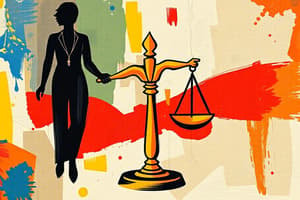Podcast
Questions and Answers
What is one major consequence of discrimination?
What is one major consequence of discrimination?
- Equal treatment among individuals
- Unequal access to resources and opportunities (correct)
- Increased access to resources
- Enhanced societal cohesion
Stereotyping has no impact on societal equity.
Stereotyping has no impact on societal equity.
False (B)
Name one way to achieve equality in society.
Name one way to achieve equality in society.
Legislation and Policies
__________ refers to unequal distribution of power among different groups or individuals.
__________ refers to unequal distribution of power among different groups or individuals.
Match the following methods of achieving equality with their descriptions:
Match the following methods of achieving equality with their descriptions:
Which type of equality emphasizes achieving identical outcomes for individuals or groups?
Which type of equality emphasizes achieving identical outcomes for individuals or groups?
Material Equality aims for equal treatment without considering individual circumstances.
Material Equality aims for equal treatment without considering individual circumstances.
What is the main goal of Equality of Opportunity?
What is the main goal of Equality of Opportunity?
______ equality implies treating all individuals with dignity and value, recognizing their inherent worth.
______ equality implies treating all individuals with dignity and value, recognizing their inherent worth.
Which type of equality often involves affirmative action programs to support disenfranchised groups?
Which type of equality often involves affirmative action programs to support disenfranchised groups?
Match the types of equality with their definitions:
Match the types of equality with their definitions:
Social Equality only focuses on material access to resources.
Social Equality only focuses on material access to resources.
What does Equality of Rights seek to ensure?
What does Equality of Rights seek to ensure?
Flashcards
Discrimination
Discrimination
Treating individuals or groups unfairly based on prejudice or bias.
Stereotyping
Stereotyping
Oversimplified beliefs about individuals or groups based on their perceived characteristics.
Power Imbalances
Power Imbalances
Uneven distribution of power among different groups or individuals, hindering equality efforts.
Social Norms
Social Norms
Signup and view all the flashcards
Legislation and Policies
Legislation and Policies
Signup and view all the flashcards
Formal Equality
Formal Equality
Signup and view all the flashcards
Material Equality
Material Equality
Signup and view all the flashcards
Equality of Opportunity
Equality of Opportunity
Signup and view all the flashcards
Equality of Outcome
Equality of Outcome
Signup and view all the flashcards
Social Equality
Social Equality
Signup and view all the flashcards
Equality of Rights
Equality of Rights
Signup and view all the flashcards
Equality of Treatment
Equality of Treatment
Signup and view all the flashcards
Equality of Respect
Equality of Respect
Signup and view all the flashcards
Study Notes
Introduction to Equality
- Equality refers to the state or quality of being equal; the same in quantity, degree, value, rank, or ability.
- This concept encompasses fairness, justice, and equal opportunities for individuals and groups.
- Different types of equality address various aspects of societal inequality.
Types of Equality
-
Formal Equality: Treating everyone the same, regardless of background or circumstance, but this can sometimes lead to unequal outcomes due to differences in starting points. Providing uniform access to education without acknowledging individual learning needs is an example. It's often a necessary but insufficient condition for true equality.
-
Material Equality: Focusing on achieving equal outcomes through resource and opportunity redistribution. This challenges existing power imbalances and aims for an equitable distribution of wealth and social resources. Affirmative action and targeted policies are examples.
-
Equality of Opportunity: Ensuring everyone has the same chance to succeed, irrespective of background. This involves removing systemic barriers like discrimination.
-
Equality of Outcome: Aiming for identical outcomes for all, recognizing societal factors and past disadvantages. Direct intervention and modification of conditions might be necessary.
-
Social Equality: Implies equal standing and respect within a society, encompassing material access, social status, integration, and cultural representation. It challenges biases, prejudices, and stereotypes.
Dimensions of Equality
-
Equality of Rights: Ensuring equal rights and legal protections regardless of background or identity (race, gender, sexual orientation).
-
Equality of Treatment: Providing equal access to resources, services, and opportunities for all, free from discrimination.
-
Equality of Respect: Treating all with dignity, recognizing inherent worth, and respecting differences.
Challenges to Equality
-
Discrimination: Denying equal treatment based on prejudice or bias, leading to inequality of access.
-
Stereotyping: Oversimplified beliefs about individuals or groups, leading to prejudice and discrimination.
-
Power Imbalances: Unequal distribution of power hindering equality. Historical injustices and systemic inequalities contribute to continued disparities.
-
Social Norms: Established customs and expectations can perpetuate inequality, particularly disadvantaging certain groups.
Achieving Equality
-
Legislation and Policies: Creating and enforcing laws promoting equality and prohibiting discrimination.
-
Education and Awareness: Increasing awareness of inequality and promoting diversity and inclusion. Challenging stereotypes is crucial.
-
Social Movements and Advocacy: Organizing and advocating for marginalized groups and challenging discriminatory practices.
-
Public Awareness Campaigns: Educating the public about inequality, empowering others to challenge discrimination.
-
Addressing Systemic Inequalities: Identifying and dismantling systemic barriers like limited access to quality education, healthcare, and economic opportunities.
Studying That Suits You
Use AI to generate personalized quizzes and flashcards to suit your learning preferences.
Description
Explore the fundamental ideas of equality, including formal and material equality. This quiz delves into the definition and types of equality, their implications on fairness, justice, and social opportunities. Test your understanding of how these concepts shape societal structures.




